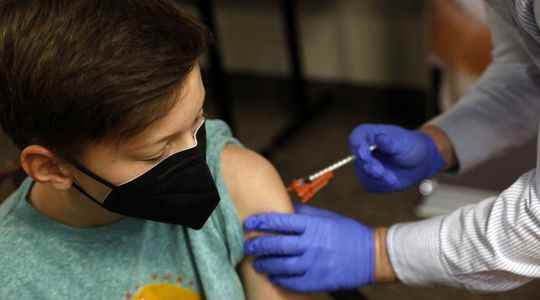The United States is slowly moving towards almost universal vaccination against Covid-19. After having started the immunization of 5-11 year olds last November, the country could soon start injections in babies, from six months old, up to still ineligible 4-year-old children, i.e. approximately 23 million people. The manufacturer Pfizer filed an emergency authorization request for its vaccine for this age group on Tuesday with the American Medicines Agency (FDA). The point on this new stage in five questions.
- What drives this decision?
Children have not been spared by Covid-19, and particularly by the highly contagious Omicron variant, with children under 4 representing more than 1.6 million cases officially detected in the United States since last spring. A high figure for a population that has also been the subject of fewer screenings. Severe forms are rarer, but they do exist. The youngest are particularly susceptible to developing pediatric multisystem inflammatory syndrome (MIS-C).
More specifically, 6 month – 4 year olds are not free of complications. These little ones have known a sharp increase in hospitalizations at the very beginning of the year, going from 50 hospitalizations in the country on December 18, to 239 on January 8, an increase of nearly 380%. In total, some 400 of them have died from Covid in the United States since the start of the pandemic, according to figures from the CDC (Centers for Disease Control and Prevention).
- Does the process change compared to adults and other minors?
Somewhat, yes. First, on the number of doses administered. Pfizer’s request initially concerns a series of two doses, but this will eventually have to include three, said the Pfizer-BioNTech alliance. in a press release. “We believe that three doses of vaccine will be necessary for children aged 6 months to 4 years in order to achieve a high level of protection against current and future variants”, also indicated the boss of Pfizer, Albert Bourla. But “if two doses are authorized, parents will have the opportunity to start the series of vaccination against Covid-19 for their child, pending potential authorization of a third dose”, he added.
This third dose, still being tested, and whose results are expected “in the coming months”, will take place “at least eight weeks after the end of the second dose”, according to Pfizer.
The other change concerns the dosage. From 30 micrograms for adults to 10 for children aged 5-11, this will be reduced to 3 micrograms for children aged 6 months – 4 years. All in order to limit side (or undesirable) effects.
- What do we know about its effectiveness?
No figures on effectiveness will be communicated. This is not what was sought by the various studies conducted by the laboratory on more than 8,000 children, over the past few months, and which focused rather on the immune responses of these children to the vaccine. In addition, only a hundred symptomatic cases were detected among the young participants, according to the New York Timeswhich distorts the different interpretations of the statistical efficiency of the injection.
However, the results were rather mixed. This immune response, in 2 to 4 year olds, first proved to be less strong than expected during clinical trials, Pfizer announced in December. Potentially due to the low dosage. Hence the use of a third dose.
“Our vaccine has already demonstrated a favorable profile in terms of safety, tolerability and efficacy in multiple clinical trials and real-world studies for all age groups from 5 years old”, judged, confident, Ugur Sahin, co-founder of BioNTech.
- When will it be available?
Pfizer’s application should be fully finalized “in the coming days”, the company said. The vaccine could thus be available for this age group in the coming weeks. Shortly after the announcement, the FDA announced that its expert panel to review the data would meet on February 15, two weeks from now. Its opinion is not binding, but generally followed by the agency.
Pfizer clarified that the filing of the data had been undertaken “after a request” from the FDA, obviously eager not to waste time and to speed up the process. Information confirmed by the acting head of the FDA, Janet Woodcock, on Twitter: “Having a safe and effective vaccine for children in this age group is a priority for the agency, and we are committed to a rapid review of data, which the agency asked Pfizer to submit in light of Omicron’s recent push.”
- Is the vaccination of children currently a success in the United States?
Not really. Started in the first days of November, the vaccination campaign for 5-11 year olds in the United States is progressing slowly. To date, only 30% of them have received at least one dose, and about 22% are fully vaccinated, according to data from the Centers for Disease Control and Prevention (CDC). As elsewhere, the United States is faced with a certain mistrust of parents. In France, the vaccination of children is even worse off, with barely 3% of 5-11 year olds having received at least one dose of vaccine since its launch on December 22.
Among 12-17 year olds, the vaccination rate reaches 56%. This time, France is doing better: eight out of ten teenagers are fully vaccinated, and nearly 10% have already received a booster dose.
